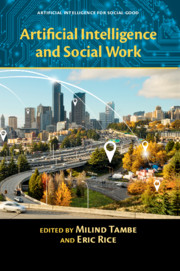Refine search
Actions for selected content:
3326 results in Artificial Intelligence and Natural Language Processing
11 - Artificial Intelligence to Predict Intimate Partner Violence Perpetration
- from Part II
-
- Book:
- Artificial Intelligence and Social Work
- Published online:
- 24 November 2018
- Print publication:
- 29 November 2018, pp 195-210
-
- Chapter
- Export citation
12 - SHIHbot
- from Part II
-
- Book:
- Artificial Intelligence and Social Work
- Published online:
- 24 November 2018
- Print publication:
- 29 November 2018, pp 211-230
-
- Chapter
- Export citation
3 - Using Social Networks to Raise HIV Awareness among Homeless Youth
- from Part I
-
- Book:
- Artificial Intelligence and Social Work
- Published online:
- 24 November 2018
- Print publication:
- 29 November 2018, pp 38-56
-
- Chapter
- Export citation
1 - Merging Social Work Science and Computer Science for Social Good
- from Part I
-
- Book:
- Artificial Intelligence and Social Work
- Published online:
- 24 November 2018
- Print publication:
- 29 November 2018, pp 3-15
-
- Chapter
- Export citation
List of Contributors
-
- Book:
- Artificial Intelligence and Social Work
- Published online:
- 24 November 2018
- Print publication:
- 29 November 2018, pp vii-x
-
- Chapter
- Export citation
13 - Ethics and Artificial Intelligence in Public Health Social Work
- from Part II
-
- Book:
- Artificial Intelligence and Social Work
- Published online:
- 24 November 2018
- Print publication:
- 29 November 2018, pp 231-249
-
- Chapter
- Export citation
Frontmatter
-
- Book:
- Artificial Intelligence and Social Work
- Published online:
- 24 November 2018
- Print publication:
- 29 November 2018, pp i-iv
-
- Chapter
- Export citation
7 - Minimizing Violence in Homeless Youth
- from Part II
-
- Book:
- Artificial Intelligence and Social Work
- Published online:
- 24 November 2018
- Print publication:
- 29 November 2018, pp 119-135
-
- Chapter
- Export citation
5 - Influence Maximization with Unknown Network Structure
- from Part I
-
- Book:
- Artificial Intelligence and Social Work
- Published online:
- 24 November 2018
- Print publication:
- 29 November 2018, pp 77-90
-
- Chapter
- Export citation
10 - A Multidisciplinary Study on the Relationship between Foster Care Attributes and Posttraumatic Stress Disorder Symptoms on Foster Youth
- from Part II
-
- Book:
- Artificial Intelligence and Social Work
- Published online:
- 24 November 2018
- Print publication:
- 29 November 2018, pp 169-194
-
- Chapter
- Export citation
6 - Maximizing the Spread of Sexual Health Information in a Multimodal Communication Network of Young Black Women
- from Part II
-
- Book:
- Artificial Intelligence and Social Work
- Published online:
- 24 November 2018
- Print publication:
- 29 November 2018, pp 93-118
-
- Chapter
- Export citation
Part I
-
- Book:
- Artificial Intelligence and Social Work
- Published online:
- 24 November 2018
- Print publication:
- 29 November 2018, pp 1-2
-
- Chapter
- Export citation
Index
-
- Book:
- Artificial Intelligence and Social Work
- Published online:
- 24 November 2018
- Print publication:
- 29 November 2018, pp 255-258
-
- Chapter
- Export citation
2 - The Causes and Consequences of Youth Homelessness
- from Part I
-
- Book:
- Artificial Intelligence and Social Work
- Published online:
- 24 November 2018
- Print publication:
- 29 November 2018, pp 16-37
-
- Chapter
- Export citation
Glossary
-
- Book:
- Artificial Intelligence and Social Work
- Published online:
- 24 November 2018
- Print publication:
- 29 November 2018, pp 250-254
-
- Chapter
- Export citation

Artificial Intelligence and Social Work
-
- Published online:
- 24 November 2018
- Print publication:
- 29 November 2018
Extractive multi-document summarization based on textual entailment and sentence compression via knapsack problem
-
- Journal:
- Natural Language Engineering / Volume 25 / Issue 1 / January 2019
- Published online by Cambridge University Press:
- 31 October 2018, pp. 121-146
-
- Article
- Export citation
Identifying signs of syntactic complexity for rule-based sentence simplification
-
- Journal:
- Natural Language Engineering / Volume 25 / Issue 1 / January 2019
- Published online by Cambridge University Press:
- 31 October 2018, pp. 69-119
-
- Article
- Export citation
NLE volume 24 issue 6 Cover and Back matter
-
- Journal:
- Natural Language Engineering / Volume 24 / Issue 6 / November 2018
- Published online by Cambridge University Press:
- 22 October 2018, pp. b1-b2
-
- Article
-
- You have access
- Export citation
MUSED: A multimedia multi-document dataset for topic segmentation
-
- Journal:
- Natural Language Engineering / Volume 24 / Issue 6 / November 2018
- Published online by Cambridge University Press:
- 22 October 2018, pp. 921-946
-
- Article
- Export citation
